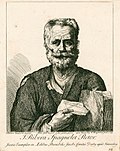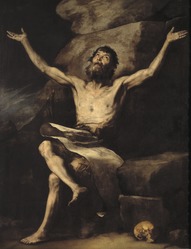File:St Paul the Hermit - Nationalmuseum - 18499.tif

Original file (2,683 × 3,502 pixels, file size: 26.9 MB, MIME type: image/tiff)
This file is from a shared repository and may be used by other projects. The description on its file description page there is shown below.
| St Paul the Hermit
|
|||||||||||||||||||||||||||
|---|---|---|---|---|---|---|---|---|---|---|---|---|---|---|---|---|---|---|---|---|---|---|---|---|---|---|---|
| Artist |
|
||||||||||||||||||||||||||
| Title | |||||||||||||||||||||||||||
| Object type |
painting |
||||||||||||||||||||||||||
| Genre |
religious art |
||||||||||||||||||||||||||
| Original caption InfoField | English: Paul of Thebaid was considered the first of the hermits of Egypt – men and women who, to escape persecution as Christians in the 3rd century, chose a life of solitude for the sake of contemplation and asceticism. According to tradition, Paul remained in the desert for almost ninety years, wearing only a garment of woven palm leaves and subsisting on fruit and bread. Edifying images of the hermits’ lives, expressing the value of penitence, were popular subjects in counter-reformation art. Ribera’s portrayal demonstrates a rare understanding of Caravaggio’s lesson. The depicted moment represents the story’s emotional climax, Paul’s ecstatic vision and mystic communion with God, symbolised by the light. The saint’s pose, with its reference to the crucified Christ, indicates his willingness to heed Christ’s call to follow him. His emaciated body is rendered with intransigent realism, every anatomical defect scrupulously transcribed. This stands in sharp contrast to the intense spirituality that radiates from his face. By working with a live model, the artist created an intensely human hero, a modern Saint Paul, and thus established an accessible role model for the faithful to emulate. Svenska: Paulus av Thebe ansågs vara den förste av de egyptiska eremiterna – kvinnor och män som för att undkomma förföljelsen av kristna på 200-talet valde ett liv i avskildhet och ägnade sig åt kontemplation och askes. Enligt traditionen tillbringade Paulus nästan nittio år i öknen, där han endast iklädd ett plagg av vävda palmblad livnärde sig på frukt och bröd. Som uttryck för botens sakrament hade motreformationens bilder på de tidigkristna eremiterna ett uppbyggligt syfte. Riberas gestaltning av botgöraren visar en djup insikt i Caravaggios konst. Ögonblicket utgör berättelsens känslomässiga klimax, där ljuset får symbolisera Paulus extatiska uppenbarelse och inre dialog med Gud. Hans pose anspelar på den korsfäste Kristus och antyder beredvillighet att lyssna till kallelsen att följa honom. Den utmärglade kroppen är avbildad med en orubblig realism och varje anatomisk ofullkomlighet är noggrant återgiven. Detta i kontrast till anletet som utstrålar andlighet. Genom att måla efter levande modell skapar konstnären bilden av en djupt mänsklig karaktär, en modern S:t Paulus, som erbjuder den troende en förebild att identifiera sig med. |
||||||||||||||||||||||||||
| Date |
1644 |
||||||||||||||||||||||||||
| Medium |
oil on canvas |
||||||||||||||||||||||||||
| Dimensions |
height: 208 cm (81.8 in) dimensions QS:P2048,+208U174728 dimensions QS:P2049,+157U174728 |
||||||||||||||||||||||||||
| Collection |
institution QS:P195,Q842858 |
||||||||||||||||||||||||||
| Accession number |
NM 1496 (Nationalmuseum) |
||||||||||||||||||||||||||
| Exhibition history |
|
||||||||||||||||||||||||||
| Inscriptions |
|
||||||||||||||||||||||||||
| References |
Nationalmuseum Sweden artwork ID: 18499 |
||||||||||||||||||||||||||
| Source/Photographer | NM 1496 | ||||||||||||||||||||||||||
| Permission (Reusing this file) |
|
||||||||||||||||||||||||||
Captions
Items portrayed in this file
depicts
File history
Click on a date/time to view the file as it appeared at that time.
| Date/Time | Thumbnail | Dimensions | User | Comment | |
|---|---|---|---|---|---|
| current | 08:56, 7 October 2016 |  | 2,683 × 3,502 (26.9 MB) | imagescommonswiki>AndreCostaWMSE-bot | {{Artwork |other_fields_1 = |artist = {{Creator:José de Ribera|workshop of}} |title = {{en|St Paul the Hermit}} {{sv|St Paulus Eremiten}} |wikidata = |object_type = |description... |
File usage
The following file is a duplicate of this file (more details):
- File:St Paul the Hermit - Nationalmuseum - 18499.tif from Wikimedia Commons
The following page uses this file:
Metadata
This file contains additional information, probably added from the digital camera or scanner used to create or digitize it.
If the file has been modified from its original state, some details may not fully reflect the modified file.
| page_data |
|
|---|---|
| page_count | 1 |
| first_page | 1 |
| last_page | 1 |
| exif |
|
| tiff_metadata_version | 1.4 |






